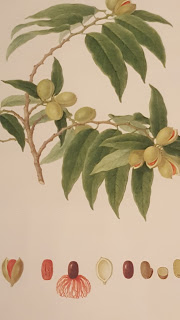Fantastically one of them was called Franz and the other was called Ferdinand. I shall resist the temptation to make jokes about indie bands and archdukes (ok, I couldn't think of any) and get straight to their story. Sons of the court painter of the Prince of Liechtenstein both Bauers spent their entire lives studying and drawing nature and even though the results of their work seem fairly indistinguishable to this layman's eye the arcs of their lives came to be very different.
Both were born in Feldsberg, Austria (now Valtice in the Czech Republic) where they were tutored by the wonderfully monikered Father Norbert Boccius to draw the local flora and fauna. Franz, who'd arrived in 1758 and was thus the eldest by two years, settled in Britain as the resident artist at the Royal Botanical Gardens in Kew but Ferdinand seemed to have the more exciting life. He explored the world from the Mediterranean to Australia filling his sketchbooks with as yet unidentified species.
Franz first came to Britain in 1788 as a guest of Sir Joseph Banks, a patron of the natural sciences who'd made his name on Captain Cook's first voyage, and was offered a position at Kew recording newly discovered plants brought back from all over the then vast British Empire. Work he diligently carried out over the next half a decade. He specialised in plants (particularly orchids) but occasionally branched out into animals and even people. The NHM vitrines contain examples of brown beard sugarbush, erica, tiger lilies, chrysanthemums, Japanese rose, Southern magnolia, ferns, corpseflower and red powder puff from Mexico (below) which was used both as livestock feed and shade for coffee and tea plants. He even illustrated brain tissue.
He combined scientific analysis with a keen aesthetic sense to provide pictures that not only helped scientists in their work but were easy on the eye as well. It seems standard procedure now but that's only because of the work of people like the Bauers. His illustrations considered diseases of wheat and corn and dissected slipper orchids. He occasionally branched out into copper engraving but it was the rather frilly, to our modern eyes, rendering of plants like the delicate lady's slipper (below) that made his name.
When he arrived in London in 1805 he set to work tirelessly converting his sketches into more precise watercolours though, unlike his brother, his work remained unnoticed outside elite scientific circles and very few were published during his lifetime. He returned to his native Austria in 1814 where he worked for another twelve years before predeceasing his brother (who is buried in St.Anne's church, Kew next to Thomas Gainsborough) by over a decade.
It's a pity because I preferred Ferdinand's flying fish, wombats, red-winged parrots, and bandicoots to his brothers stiller studies. Prior to joining the HMS Investigator, Ferdinand had travelled extensively around Greece and Asia Minor with John Sibthorp, Professor of Botany at Oxford University. There he'd completed a ten volume compilation of his sketches called Flora Graeca.
Other animals Ferdinand depicted included rainbow lorikeets, a platypus, koalas, wallabies, and the unfortunately named weedy sea dragon. Even Ferdinand's floral drawings have a slight edge over his more acclaimed brother. They're almost identical to look at but there's something in the fact that Ferdinand traversed thousands of miles to reach his subjects that makes them more impressive. The red flowered kurrajong from the North Island in Australia's Gulf of Carpenteria is believed to be the first of its kind in existence. The Queensland nutmeg, below the kurrajong, can also only be found in Australia, the Solomon Islands, and Papua New Guinea.
So it was a rather dry exhibition and even though there was a couple of touch screens it was reminiscent of the old days of museums before interactivity ruled the roost. But it was no less informative or interesting for that. I'm not sure I'd want to spend four years on a boat in the early part of the nineteenth century but I'm glad somebody did.













No comments:
Post a Comment